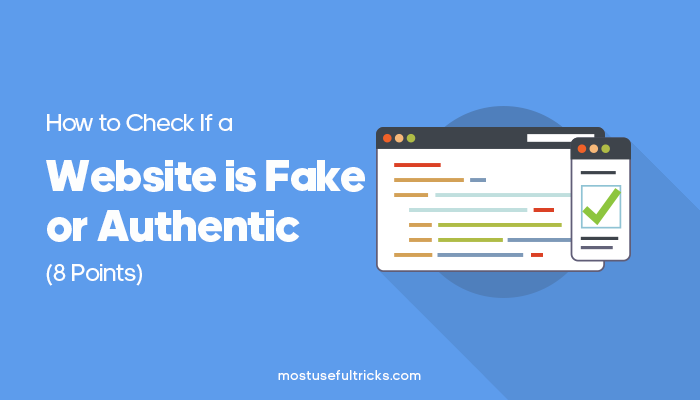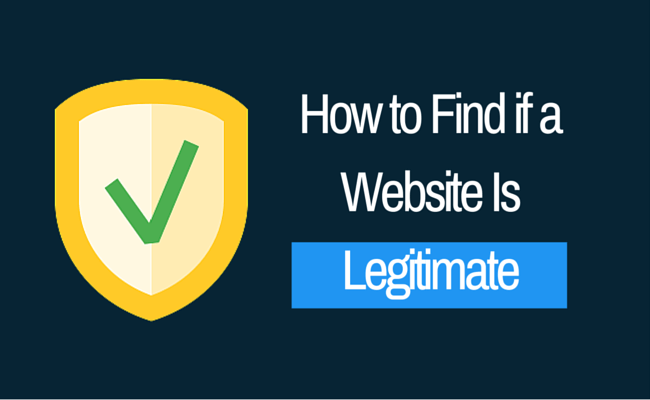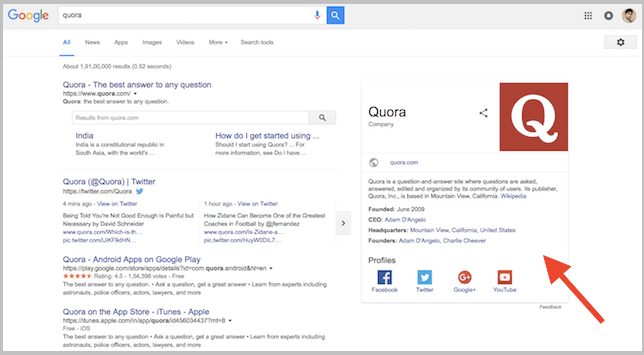The whole Internet contains an enormous number of sites. There are thousands of websites on nearly every topic. Starting with Harry Potter fan club forums to buying Potato Chips websites, every niche has its own space on the internet. So how to check if a website is fake or authentic?

Sites like Facebook.com, Google.com, etc., have gained fame. We all use them every single day. These are trusted sites; most of you trust Google, right?
Today, the internet is way safer than how it was a few years back, but we can’t deny that scam sites exist on the web—sites that provide fake info, sites that steal your credit card info, and many others.
Now the question is – While there are millions of websites on the web, how to find a fake or dangerous site to visit. This question was asked by one of my blog readers.
If you subscribe to this blog’s newsletter (which you should), the first email you receive is about if you have any How-to-Guide-like questions you want to be answered. Now, many people send me a reply to that email to which I reply. In response to that email, one of my subscribers asked –
Hi,
I really want to know how to ascertain whether a website is authentic or fake. I’ve googled regarding this stuff but couldn’t find proper info. So can you please offer me detailed info regarding this aspect?
Thanks.
So, this post is the answer to that email. Here I have listed some points which you can check to determine and get an idea about a website’s legitimacy. So let’s get started with the answer.
In this post, we’ll explore:
What are Fake Sites?
Before digging into the answer, let me let you know what a fake site is. Some businesses associate with fraudulent activities on the web. They spread fake news stories to attract people. Instead of real news about the products, they impersonate being someone else. These sites are fake websites. Now let’s find out how to identify fake sites.
Many people face fake news issues in the morning while reading news online. Those who are unaware of the official sites go to a search engine and type any random news on the address bar. They end up reading fake news stories and believe in them. A Fraudster, Hackers, and internet attackers all over the world build such websites and target people. They offer digital payment services, e-commerce, and other services where one needs to make payments. This way, hackers snatch money from people across the globe.
How to Find if a Website is Legitimate or Fake

Below I have shared some steps or methods. This will help you to identify fake websites.
1. Most sites should have few social media pages like a Facebook page, google plus page, Twitter, and other social media profiles. Search for the official social media pages, check their fan count, and see the engagement of those posts (likes and comments).
2. A reputed and old site should have a Wikipedia page. Check the domain/internet company you are trusting has a Wikipedia page or not.
3. A legitimate website should have all the important pages like About Us, Contact Us, Privacy Policy, and Disclaimer. You can read those pages that can give a lot of info regarding that site.
4. You can go to Who. is and enter the domain name; you will see the date when a domain was brought. It should surprise you if you see a website with thousands of pages that are only 1 or 2 months old.
5. Check how the site looked a few months or years back. You can use services like the Wayback machine to see how a website looks and works when it was new. This will help you to identify if the site is trustable or not.
6. If you are talking about an e-commerce site, the site should have an HTTPS (secured) checkout page. HTTPS makes your online transactional activities safe and encrypted.
7. You can always do a simple Google search about “Is Domain.com (the site) is legit or not.” In many cases, you will see already other people have shared their experience with that website on any blog or forum.
8. If a site is popular, then by searching its name on Google, you should see a knowledge graph on the right side of the page. (See Screenshot Below)
9. Use a web safety tool to find whether the site is legit or fake. In the case of e-commerce sites, it is important to know whether your transactions are safe or illegitimate.
10. many internet users are unaware of the official sites of a particular product or service. For example, major news organizations and their official site. It creates massive confusion, and users end up getting fake news.
Please Note: These checkpoints are not 100% accurate. For instance, maybe a new site doesn’t have any social media pages or anything else; that doesn’t mean that the site is fake.
These points should give you a brief idea about how you should check the info about a site, but that doesn’t mean that if a site doesn’t comply with all of these, then it’s not trustable.
Another thing is most of the new sites don’t have that many social fans or Wikipedia pages (and others). If you take the example of this site only (MostUsefulTricks.com), you will see that I don’t have many fans on Facebook or a Wikipedia Page. Anyhow, I think you understand what I mean to say here. Anyhow, thanks for reading. Have an awesome day!
How Can I Combat Fake News and Fake News Stories?
Always keep in mind that fake news is fabricated information that is created to manipulate others. Study the news stories and information properly for fact-checking. If you are confident and sure that a particular content fits in the category of fake news, be smart about it by not sharing it with others at all.
By sharing and commenting on it isn’t helpful. It only allows the fake news to spread further in the new stories and ears of the public. Instead of spreading fake news, the ultimate goal should be to avoid it and ignore it.
If you stumble upon fake news and news stories that are misinformative and manipulative, you can always take action. If a trending post contains misinformation, you can “hide” it. If specific users are repeatedly on your feed sharing and misguiding, you can always block them. If you’ve previously “liked” or subscribed to a page that is churning out fake news, unsubscribe to that page or block that domain name. If a reporter on live television does so, the public can always stand up against them as well.
You can also read an article on Adblock Plus vs uBlock Origin: Which Is A Better Adblocker that blocks unwanted ads and websites.
F.A.Qs
1. Go to Google
2. Safe Browsing Mozilla
3. Protect the Fox Microsoft allows its users to report malicious sites within its browsers. You can do this by going to the Tools/Safety menu, selecting Phishing Filter/SmartScreen Filter, and clicking “Report Unsafe Website.”
Conclusion
Sometimes it is hard to find differences between fake and real sites. Some companies and social media companies claim there are legitimate. Thousands of people fall for them. However, their URL, content, and other mentioned elements help to distinguish. Some website fact-checkers help users to find legitimate sites on the web. Especially at the time of the presidential election, it is hardest to find the news source as there is a lot of news on various factors roam around. Reporters and journalists made fake headlines on digital news and other news outlet and made it seemed like the news is a credible news story. You can check it, verify it and make sure that you are dealing with real people and a real website. Avoid phishing sites and follow the real domain/actual domain.
Ask us about source phishing detection, Malware Detection, safety report, malicious websites, illegitimate sites, fraudulent sites, detection strategies, domain extensions, safety rating, secure connection, online website reputation, complete website scanning, one-off sites, or anything from the article.
The above-mentioned tips and users’ common sense will help one find a legal site among zillions of sites available on the web. Comment below and let us know if you have encountered any fake news sites.

